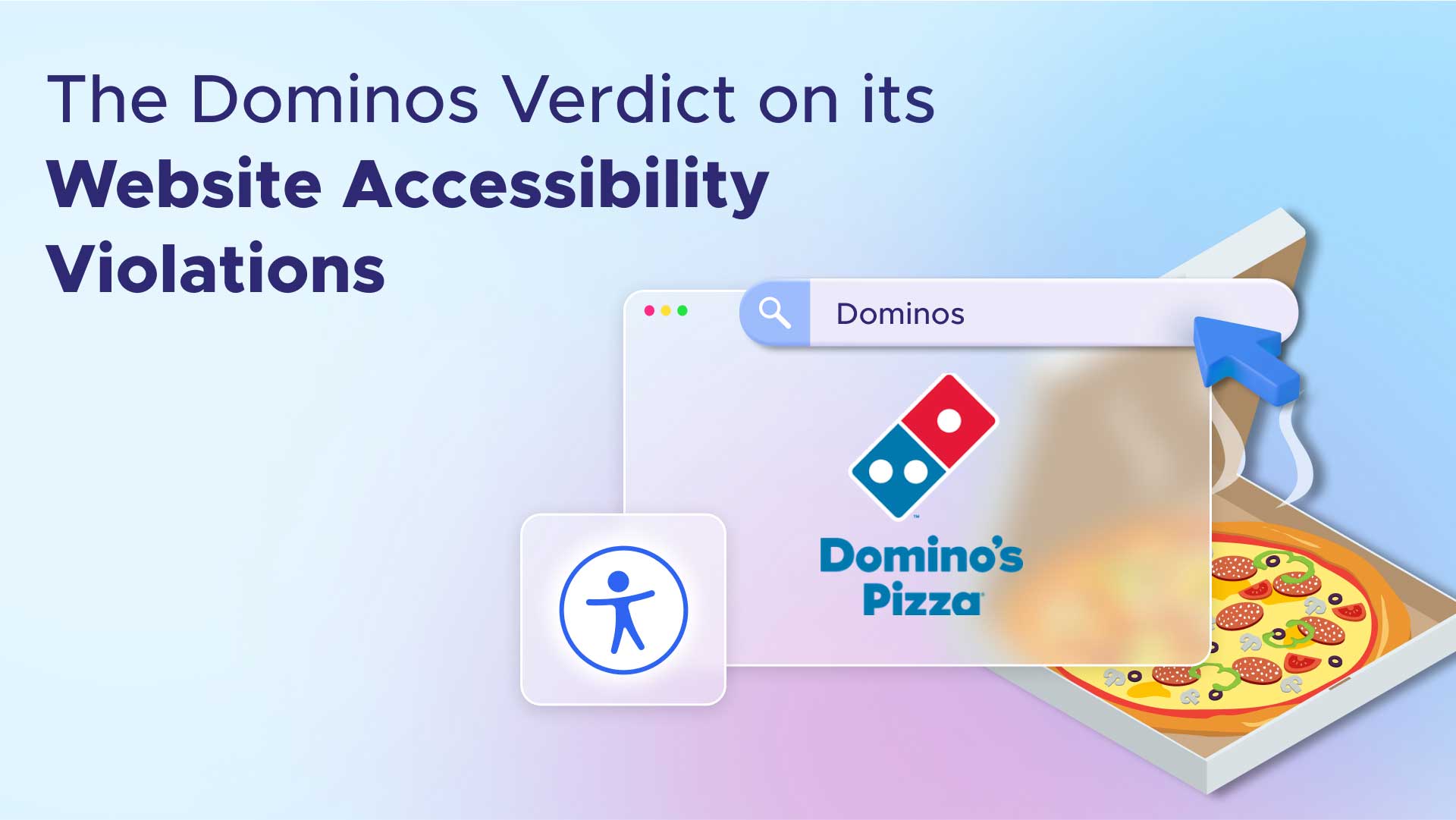The Domino’s ADA Lawsuit – The Cost of Non-Compliance

Domino’s Pizza. A wildly successful brand selling the world’s most popular food. Long before the Domino’s American with Disabilities Act (ADA) lawsuit took place, the pizza company had started as a grassroots business in 1960, founded by two brothers who had little cash or business acumen. Their aim was simple; to deliver freshly-made pizzas with efficiency and contribute actively to the local community.
The company quickly rose to success, using business-savvy strategies such as setting up pizzerias in locations accessible for college students, who made up some of their core audience.
Fast forward to 2016 and the multinational pizza chain was hit by an ADA lawsuit, pushing the company’s digital accessibility under the spotlight.
This blog will look at the events surrounding the Domino’s ADA accessibility lawsuit. It will also give you tips on how your business can avoid lawsuits and move your own website towards compliance.
The Domino’s Accessibility Lawsuit – a Five-Year Saga
The Domino’s accessibility lawsuit story begins in 2015 when Guillermo Robles, a blind man, was unable to order a pizza online from Domino’s website and mobile app using his screen reader. In 2016, Mr. Robles filed a lawsuit in the U.S. District Court, Central District of California. He claimed that Domino’s website and mobile app were inaccessible to him, and other blind or visually-impaired people using screen readers, in violation of the ADA and California’s Unruh Civil Right Act (UCRA).
Robles alleged that Domino’s website graphics were missing alternative text (alt text) and featured hyperlinks with no text to add context for the link. These accessibility errors made it challenging for Robles to navigate its website using a screen reader. Robles claimed that simple compliance with WCAG Guidelines, the internationally recognized set of standards for online and mobile content, would provide him and other visually impaired consumers with equal access.
In 2017, Robles’ lawsuit was dismissed by the U.S. District Court. In its decision, the court ruled that the ADA Title III requirement of accessibility for “services of a public accommodation” applies to Domino’s website and mobile app. The court made this initial ruling because the ADA predates the Internet and therefore makes no mention of e-commerce. However, the Court ultimately concluded that Domino’s was not required to comply with WCAG 2.0 because the U.S. Department of Justice (DOJ) did not set WCAG as the standard for digital accessibility. Requiring Domino’s to comply with WCAG would violate its constitutional right to due process.
Mr. Robles appealed the Court’s decision to the U.S. Court Of Appeals, Ninth Circuit. In 2019, the appellate court rendered a decision and made the following rulings:
- The ADA applies to websites and apps when there is a sufficient nexus with a physical location. Domino’s website and app are two of the primary ways of ordering Domino’s products to be picked up at or delivered from Domino’s restaurants. This “nexus” of the website and app to the restaurants qualify them as “service of a public accommodation” and thus are required to be accessible under Title III of the ADA.
- A court can order a business to comply with WCAG as a remedy for violating the ADA. Domino’s due process rights were not violated because it had adequate notice that it was required to comply with the ADA. The fact that the DOJ did not create any regulations regarding web accessibility standards was no excuse because compliance with WCAG can be ordered by the court as a remedy.
Based on this reasoning, the appellate court reversed the district court’s decision and ordered it to make a ruling on whether Domino’s website did indeed violate the ADA after the parties go through discovery, i.e. gather evidence, to each make their case.
Domino’s appealed the decision to the US Supreme Court. Its request to hear the case was denied.
The parties then proceeded to go through costly discovery, including multiple depositions, expert witnesses and extensive filing of motions with the court. After discovery ended, both Domino’s and Mr. Robles filed motions requesting that the Court rule in their favor.
In 2021, the judge found that Domino’s website violated the ADA and UCRA and ordered the pizza chain to comply with Website Content Accessibility Guidelines (WCAG) 2.0, the internationally recognized set of standards for online and mobile content. Domino’s was also fined under the UCRA. Before the issue of the amount of attorney’s fees due to the plaintiff was decided, Domino’s settled the case.
Domino’s endured five years of litigation and paid an untold amount of attorney’s fees.
Screen Readers: Meeting the Expectations of the Visually Impaired
“Everyone, if they live long enough, will experience
at least one eye condition in their lifetime.”
World Health Organization (WHO), 2023
The Domino’s accessibility lawsuit highlights that it’s a legal imperative to make sure your websites are usable for people using screen readers, especially if your website is a path to purchase for goods and services at a physical location, by bringing them up to WCAG standards. And, with an estimated 2.2 billion people worldwide that have some form of visual impairment or blindness, you can guarantee that many people who interact with your website will be using Assistive Technology (AI).
If screen reader technology is unfamiliar to you, let’s take a look at exactly what they are and how they’re used.
What are screen readers?
Screen readers are applications that turn on-screen content into speech or present that content on a Braille display. Screen reader users are able to select words or passages they want to hear, giving them the ability to search for specific pieces of text and adjust settings such as speed and speech volume.
Provide a framework for designing content that works with screen readers — along with other assistive technologies.
Making your web content accessible for users of screen readers is a multi-layered and continuous project, however, there are some key actions you can take today that will help you design your website in line with WCAG.
3 ways to make your website accessible for screen reader users
Making your websites and mobile apps usable and barrier-free for people with visual disabilities covers many different components. Here are three of some of the most effective ways you can add functionality to your digital content as you progress on your digital accessibility journey:
1. Make it accurate – alt text
Alt text (or alternative text) gives users of screen readers a way to understand digital content such as images and videos. alt text provides context for people who use screen readers and other assistive technology, giving people with visual disabilities a rich user experience. Check out UserWay’s alt text tips here.
2. Keep it clean – HTML tags
Make sure your website uses HTML tags to clearly convey your message andorganize your pages in contextual, predictable ways. Make sure that your HTML tags give users of screen readers the freedom to quickly find the content they need, when they need it, in the way they want to access it.
3. Make it rich – WAI-ARIA
It’s worth bearing in mind that assistive technologies may not always work well with dynamic web content or interactive elements such as drag-and-drop functionality. If your native HTML isn’t functioning for screen readers, this is where WAI-ARIA language (Accessible Rich Internet Applications) comes in. UserWay’s AI-Powered Accessibility widget shows you alternative text and ARIA labels for on-screen elements with a simple mouse hover.
Making your websites usable for people using screen readers is an important step of every businesses’ digital accessibility journey. You’ll not only broaden your audience to millions of people with visual disabilities, you’ll also avoid lawsuits, legal fees, fines and potential reputational damage.
UserWay Brings Your Website Closer to Compliance
Being such a highly visible case, the Domino’s ADA lawsuit was another case that placed digital accessibility in the limelight.
With pizza being the first food sold online and the first food to be delivered into space, it’s fair to say that delivering web accessibility should really be next on the menu.
Ready to make your website accessible for screen reader users? Get in touch for a chat or a demo today.
Common FAQs
How can I make my website accessible for people with visual disabilities?
Bringing your website closer to compliance with the highest of WCAG standards will put you in a good place on your digital accessibility journey. Consider how users with visual disabilities will interact with your content such as font sizing, color contrast, headings and moving images. Take advantage of UserWay’s AI-Powered Accessibility Solution to help you detect and remediate accessibility issues, closing gaps with your alt text, H Tags or missing ARIA labels.
How can I identify the web pages that need correction?
The Domino’s accessibility lawsuit brought to light that it’s not only your website that needs to be brought into compliance, it’s also your mobile apps. UserWay’s Accessibility Scanner quickly checks your website for WCAG conformance and will flag issues that may only appear across devices. Our scanner can perform 30,000 scans on mobile and desktop sites with more than 15,000 pages – in under an hour. UserWay’s Accessibility Scanner doesn’t just identify the violations on your site – it also specifies which violations to correct first.
My website is already accessible for users of screen readers – how does this apply to me?
Making your web content accessible for people with visual disabilities is a great first step to your accessibility journey, however, although screen reader usability is a huge part of that journey, it isn’t the destination. It’s important for businesses to approach digital accessibility in a 360-degree way. Take time to get to grips with WCAG requirements and be sure to stay on the pulse of standards as they evolve to prevent potential liabilities. Partner with an accessibility expert who can help you quickly identify any other areas of your website that you may have overlooked.




Share